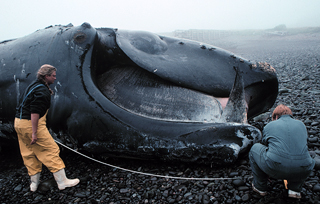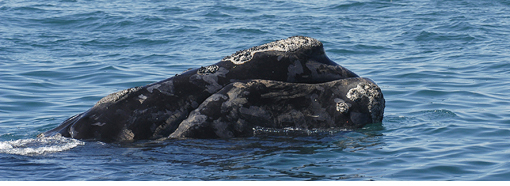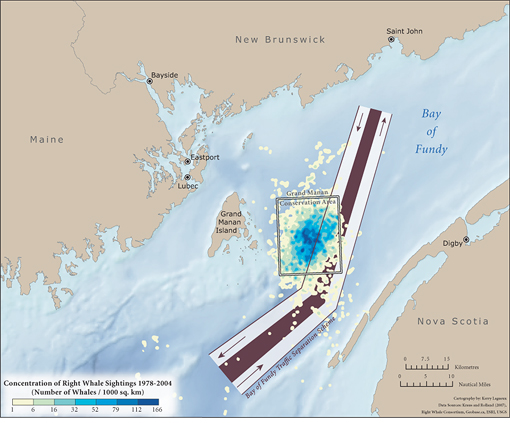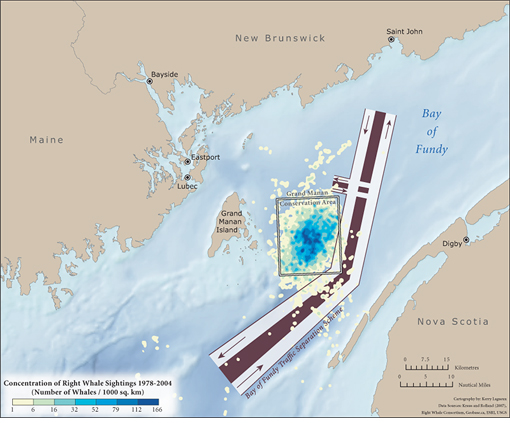


In 1982, the Bay of Fundy Traffic Separation Scheme (shipping lanes) was adopted by the International Maritime Organization (IMO) and implemented by Transport Canada in 1983 to organize vessel traffic through an area used extensively for fishing. The shipping lanes are mandatory for all vessels over 20 m in length. At that time, little was known about the distribution of right whales in the Bay of Fundy and the threat of vessel strikes to their numbers. Between one-third to one-half of the known right whale population has been seen every year in the lower Bay of Fundy since 1980. A portion of the Bay of Fundy favoured by right whales for feeding and socializing is transected by the mandatory shipping lanes used by large vessels including tankers, containers ships, cruise ships and bulk carriers.

In 1992, Delilah was struck by a vessel and died in the
Bay of Fundy. Delilah’s skeleton and near life-size model
are on display at the New Brunswick Museum,
Saint John, New Brunswick.
In 1992, a right whale died after being seen thrashing at the surface by a recreational boater and his family near Grand Manan. Another large right whale and a much smaller whale were seen nearby. The carcass of the whale drifted ashore on Grand Manan a couple of days later and a detailed necropsy was performed by veterinarians and researchers with help from local residents. The cause of death was attributed to a vessel strike. Researchers at the New England Aquarium determined from the photographs taken that this was an adult female, known as Delilah and she was with her calf when she died. The orphaned calf, later named Calvin was not seen again in 1992, but showed up in the Bay of Fundy a year later. Delilah's death was not an isolated incident. Although this was the first known ship strike mortality of a right whale in Canadian waters, several had previously been documented in the American waters 1. Two more deaths from vessel strikes in the latter part of the 1990s in the Bay of Fundy led to an analysis of right whale sighting data and vessel traffic.

Delilah's orphaned calf, named Calvin survived. 13 years later in 2005 she brought her female calf to the Bay of Fundy nursery ground.
In 2000, analyses of data from 14 years of right whale surveys and radar tracking data of vessel movements illustrated the overlap between high densities of right whales and the outbound shipping lane. A relative probability analysis of the vessel and whale data showed that a relocation of the traffic separation scheme to an area with lower whale densities could reduce the probability of ship and whale interaction by 80%.
In December 2002, the collaborative effort between government agencies, the shipping and fishing industries, and the scientific community was rewarded by the adoption by the International Maritime Organization (IMO) of the amended traffic separation scheme. The full implementation of the change occurred on July 1st, 2003.


Right whale density in the Bay of Fundy in relation to the old shipping lanes (top) and the amended shipping lanes (bottom).
The new shipping lanes had an effect on commercial activities in the region: fishermen from Nova Scotia now do some of their fishing in the lanes instead of east of them and ships' passages are longer by 9 km (4.9 nautical miles) for the port of Saint John, New Brunswick, and 20 km (10.8 nautical miles) for the port of Eastport, Maine. Despite these inconveniences, both industries supported the proposal and their stewardship contributed to the recovery of the species in the Bay of Fundy.
Timeline
* Vessel Whale Working group: Canadian Whale Institute/Center for Coastal Studies (M. Brown, co chair); and Transport Canada Marine Safety (G. MacCaull, co chair); Furcan (M. Long); F.K. Warren (S. Perry); Saint John Port Authority (P. Turner); Atlantic Pilotage (P. Gates); Marine Communication and Transportation Services (Fundy Traffic, F. Webster and C. Middleton); Irving Oil (R. Goddard and J. Logan); Grand Manan Fishermen's Association (K. Sonnenberg); Maritime Fishermen's Union (H. Saulnier); and World Wildlife Fund (C. Merriman).

1 Kraus, S. D. 1990. Rates and potential causes of mortality in North Atlantic right whales (Eubalaena glacialis). Marine Mammal Science 6:278-291.
2 Brown, M. W., J. M. Allen, and S. D. Kraus. 1995. The designation of seasonal right whale conservation zones in the waters of Atlantic Canada. Pages 90-98 in N. Shackell and M. Willison, eds. Marine Protected Areas Association, Wolfville, Nova Scotia, Canada.
3 Brown, M. W. 1994. Caution mariners: Please avoid collisions with right whales. Prepared for the Minister of Supply and Services, Communications Directorate, Department of Fisheries and Oceans (DFO/4982), Ottawa, Ontario, Canada.
4 Anonymous. 2000. Canadian Recovery Plan for the North Atlantic Right Whale. World Wildlife Fund Canada, Toronto, Ontario; Department of Fisheries and Oceans, Dartmouth, Nova Scotia, Canada.

